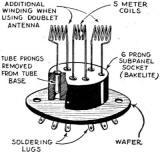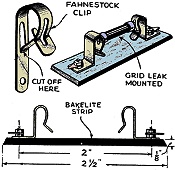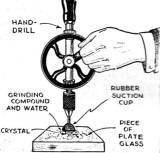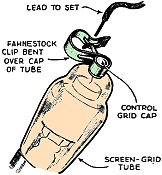|
October 1935 Short Wave Craft
 [Table
of Contents] [Table
of Contents]
Wax nostalgic about and learn from the history of early electronics. See articles
from Short Wave Craft,
published 1930 - 1936. All copyrights hereby acknowledged.
|
 If MacGyver had been around in 1935, every episode would likely
have included a Fahnestock Clip
as part of a scheme to get Angus (his first name - no kidding) out of perilous situations.
The handy little devices were very popular in electronics, both for hobbyists and
for commercial products, until fairly recently (within the last two decades) because
they provide a simple, reliable electrical connection that does not require any
tools for use - other than your finger. If you have never heard of a Fahnestock
clip, you will probably be surprised to learn what it is and chances are you have
seen one and maybe even used one. If you work in an electronics prototyping lab
area that has been around for a while, there are almost certainly some in a parts
bin somewhere or on some old mock-up gathering dust in the corner. I mention Fahnestock
clips because this 1935 edition of Short Wave Craft magazine shows them
being used in two of their monthly hints and kinks page. If MacGyver had been around in 1935, every episode would likely
have included a Fahnestock Clip
as part of a scheme to get Angus (his first name - no kidding) out of perilous situations.
The handy little devices were very popular in electronics, both for hobbyists and
for commercial products, until fairly recently (within the last two decades) because
they provide a simple, reliable electrical connection that does not require any
tools for use - other than your finger. If you have never heard of a Fahnestock
clip, you will probably be surprised to learn what it is and chances are you have
seen one and maybe even used one. If you work in an electronics prototyping lab
area that has been around for a while, there are almost certainly some in a parts
bin somewhere or on some old mock-up gathering dust in the corner. I mention Fahnestock
clips because this 1935 edition of Short Wave Craft magazine shows them
being used in two of their monthly hints and kinks page.
BTW, I never have been really comfortable referring to a "kink" in
a discussion of a solution to a problem since Merriam-Webster defines a kink as
"a small problem or flaw." It is still done routinely today in hobby and professional
technical magazines. Oh, and the $5 prize in 1935 is equivalent to $113.99 in 2024
per the BLS
Inflation Calculator.
$5.00 for Best Short Wave Kink
 The Editor will award a five dollar prize
each month for the best short-wave kink submitted by our readers. All other kinks
accepted and published will be awarded eight months' subscription to Short Wave
Craft. Look over these "kinks" and they will give you some idea of what the editors
are looking for. Send a typewritten or ink description, with sketch, of your favorite
short-wave kink to the "Kink" Editor, Short Wave Craft. The Editor will award a five dollar prize
each month for the best short-wave kink submitted by our readers. All other kinks
accepted and published will be awarded eight months' subscription to Short Wave
Craft. Look over these "kinks" and they will give you some idea of what the editors
are looking for. Send a typewritten or ink description, with sketch, of your favorite
short-wave kink to the "Kink" Editor, Short Wave Craft.
$5.00 Prize Winner
 Ultra S-W Plug-In
Coils Ultra S-W Plug-In
CoilsThis sketch as drawn shows how I have put to good use the prongs
removed from tube bases. The advantage of being able to remove the coils (5 meter)
for any necessary change or adjustment can be seen at once.
The ICA socket was chosen because the double contact within the socket held the
coils firmly in place and practically eliminated the possibility or poor joints
and noise. One suggestion - solder the connections well, using rosin core solder.
"Tin" the ends of each coil end before inserting it into the prong. Do a thorough
job the first time! You won't have to do it over again and the results will be well
worth the additional effort.
- Harold J. Clark.
 New Use for Old Toothbrush New Use for Old ToothbrushMany
short-wave "Fans" have found occasion to employ a screwdriver made of some insulating
material for adjusting trimmer condensers in antenna circuits or I.F. transformers.
By removing the brush portion of a discarded tooth brush and filing a flat edge
on the handle, an excellent non-magnetic screwdriver can be made. I trust this kink
will be of value to the readers of Shot Wave Craft magazine.
- Charles Pfleuger.
 Eliminating Fringe Howl and Motorboating Eliminating Fringe Howl and Motorboating
Fringe howl and motorboating may be eliminated by simply placing a resistor across
the secondary of the A.F. transformer leading to the troubled stage. This method
does not give maximum results. The resistor is to drain off audio voltage, but if
it is too low a value, you will get weak signals. If it is too high, the receiver
will howl. To get best results, put a 250,000 ohm potentiometer across the secondary
of the audio transformer so that the optimum resistance may be found. This potentiometer
also acts as a smooth working volume control. I find this system very successful
and satisfactory.
- Phil Reich
 Code Practice Oscillator Code Practice Oscillator
Here is my favorite kink and I hope that it is published in Short Wave Craft.
A center tapped push-pull input transformer may be connected as shown in the diagram
and will make an excellent code practice oscillator. The oscillation is very good
and it has an excellent tone. The tone of course, will depend a lot upon the tube
and make of transformer used. Either a 56 or a 76 tube will work very nicely; 6.3
volts are used for the 76., while 2.5 volts are used for the heater of' the 56.
The output of this oscillator is sufficient to operate a small speaker with excellent
volume.
- Vic Mountain.
Easily Adjustable Antenna Condenser
 Probably many S.W. "Fans" have pondered
over the inconvenience of adjusting the antenna condensers with a screwdriver. Here
is my solution to the problem. Probably many S.W. "Fans" have pondered
over the inconvenience of adjusting the antenna condensers with a screwdriver. Here
is my solution to the problem.
The small knob serves as an insulated hand adjustment and forces the movable
plate down very evenly.
- Fred Tann
 Grid Leak Mounting Grid Leak MountingMany set builders
use grid-leak mountings and here is a stand made from two Fahnestock clips, one
inch in length. Details of how to make this two-cent G.L. stand are shown in the
diagram. This stand is very rigid and holds grid-leaks very tightly. The clip (F.C.)
should be shaped out, as shown in plan. The clips (C) should then be mounted on
the strip of bakelite (B) with screws (S) together with the soldering lugs (L).
A hole should be drilled in the center of the strip of bakelite for mounting.
- Stanley J. Kauklis.
Grinding Your Own Crystals
 Here is a kink that I would like to enter
in the short-wave kink contest. In grinding crystals I used the regular method of
a piece of plate glass, grinding compound, and water. Here is a kink that I would like to enter
in the short-wave kink contest. In grinding crystals I used the regular method of
a piece of plate glass, grinding compound, and water.
- Edwin Cheever.
 Handy Grip Cap Handy Grip CapIn one of your
issues you published a kink employing a Fahnstock clip as a connection for the control-grid
or a screen-grid tube. The illustration shows a much better way to use this slip
for the same purpose. These clips are obtained from discarded "B" batteries and
are ideal for this purpose because they have exceptionally long ends.
- Frank Pulaski.
A Real Vernier
 Here is a kink
that has helped to bring in many DX stations. All that is needed is a round eraser
and a piece of fairly stiff brass. The eraser is fastened to the bracket and the
bracket to the panel with small bolts. A station is tuned in with the dial and for
fine adjustment a little pressure on the eraser and a beautiful vernier is the result.
If a small dial is used the eraser may be mounted on a bracket so it touches the
edge of the dial as in B. Here is a kink
that has helped to bring in many DX stations. All that is needed is a round eraser
and a piece of fairly stiff brass. The eraser is fastened to the bracket and the
bracket to the panel with small bolts. A station is tuned in with the dial and for
fine adjustment a little pressure on the eraser and a beautiful vernier is the result.
If a small dial is used the eraser may be mounted on a bracket so it touches the
edge of the dial as in B.
- Chas. R. Steegmuller.
Eliminating Hum
Here's a kink for eliminating hum, that will save a good many experimenters a
good many dollars in power supply filter. When the power supply is built, place
the power transformer in its permanent position, and then with nothing else mounted
in the power supply, turn on the transformer. Connect a pair of headphones across
the filter choke. An "induction hum" may be heard. By turning the choke at various
angles, a location will be found where no hum is audible in the headphones. Locate
the choke in that position permanently, and then wire up the power supply and filter.
Using this system, it is often possible to get complete filtering with only one
5 henry choke and two 1 mfd. condensers. The proper location for microphone transformers,
audio transformers, modulation chokes, etc., may also be found in this manner when
it is necessary to mount these units on the same base as the power supply.
- Frank E. Shopen.
 Home-Made Neutralizing Condenser Home-Made Neutralizing Condenser
A condenser that can be used as an antenna trimmer on receivers or as a neutralizing
condenser on transmitters can be made from two midget stand-off insulators and two
stator plates from an old discarded variable condenser.
The stand-off insulators used are about 1 5/16" high. A bakelite or wooden rod
that is pointed is used to adjust the rotor. When the neutralizing adjustment is
made, the rotor can be locked into place by tightening the nut indicated on the
diagram.
- Joe Balas.
E.C. Detector
 Here is my kink
which I hope will be given consideration when you decide the winner for the best
kink of the ones submitted. It is a method by which a two-circuit detector using
the regeneration control in the screen-grid circuit may be converted into an electron-coupled
detector. Only a few changes need be made in the wiring, and no extra parts need
be added to the detector. Here is my kink
which I hope will be given consideration when you decide the winner for the best
kink of the ones submitted. It is a method by which a two-circuit detector using
the regeneration control in the screen-grid circuit may be converted into an electron-coupled
detector. Only a few changes need be made in the wiring, and no extra parts need
be added to the detector.
Since the electron-coupled detector is more preferable than the usual two-circuit
detector, readers of your magazine will find this kink valuable. I have enclosed
a short description and a diagram of' the kink, which I think every radio "Fan"
can easily use to his advantage.
- Seiko Yakahi.
Posted May 10, 2024
(updated from original post
on 1/12/2015)
|






















